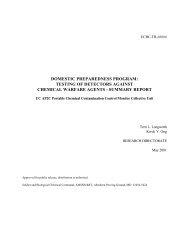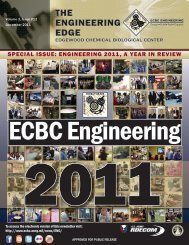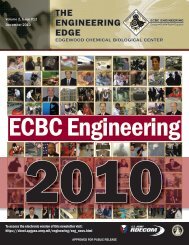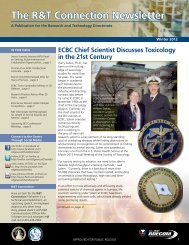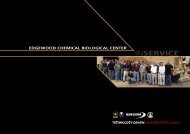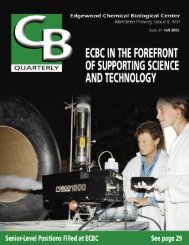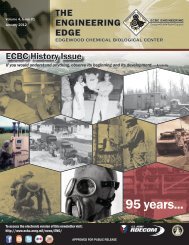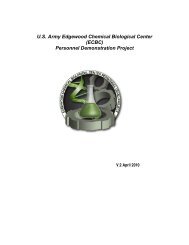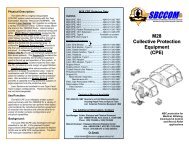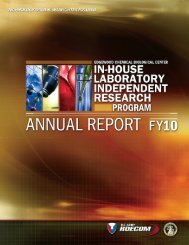(FFPE) with Self-Contained Breathing Apparatus (SCBA) for Rescue
(FFPE) with Self-Contained Breathing Apparatus (SCBA) for Rescue
(FFPE) with Self-Contained Breathing Apparatus (SCBA) for Rescue
Create successful ePaper yourself
Turn your PDF publications into a flip-book with our unique Google optimized e-Paper software.
APPENDIX A<br />
Summary of Man-In-Simulant Test (MIST) Trials<br />
The maximum exposure times recommended in this report are based on an extensive series of<br />
tests conducted at the Edgewood Chemical Biological Center (ECBC), Aberdeen Proving<br />
Ground, MD. These tests provided raw data <strong>for</strong> modeling the Physiological Protective Dosage<br />
Factors (PPDF) used in this report. The PPDF is defined as the ratio of the dosage that affects a<br />
protected person divided by the dosage that similarly affects an unprotected person. Firefighters<br />
in turnout gear <strong>with</strong> properly fitted <strong>SCBA</strong> per<strong>for</strong>med mock rescue operations <strong>for</strong> 30 minutes<br />
inside a chamber filled <strong>with</strong> a non-toxic chemical vapor that simulates the vapor properties of an<br />
actual chemical agent.<br />
The full explanation of the <strong>FFPE</strong> MIST tests and test results are being incorporated into a<br />
technical report by ECBC. This report, when completed, will be available on the SBCCOM<br />
Homeland Defense Web site at http://www.ecbc.army.mil/hld/ip/reports.htm.<br />
The tests, known as Man-In-Simulant Test (MIST) trials, measured how well <strong>FFPE</strong> protected 17<br />
individual areas of the body compared to having no protection. The U.S. Army SBCCOM<br />
Domestic Preparedness Chemical Team, also sponsored MIST testing at the Royal Military<br />
College (Kingston, Ontario, Canada) that confirmed and independently validated the ECBC test<br />
results.<br />
The MIST trials were conducted <strong>with</strong> volunteer career firefighters. For each test, special vapor<br />
samplers are placed on the skin of a test subject volunteer at 17 different locations. These<br />
samplers absorb chemical simulant vapor at the same rate that human skin absorbs chemical<br />
agent vapor. Then the test subjects don standard turnout gear <strong>with</strong> <strong>SCBA</strong> and enter a vapor<br />
chamber containing a measured concentration of simulant vapor and per<strong>for</strong>m a specific series of<br />
activities that represent actions expected while rapidly rescuing an individual from a chemically<br />
contaminated environment. After 30 minutes, the test subjects leave the chamber and doff their<br />
protective clothing. The samplers are removed and analyzed to determine the amount of<br />
simulant vapor collected by each sampler. This indicates the amount of vapor exposure in the<br />
body region where each sampler was placed and provides evidence of the protection offered to<br />
each skin area by each tested configuration.<br />
The MIST trial results then were used in modeling to determine, based on known physiological<br />
thresholds and effective dosages, the local and/or systemic potential effects of each of the<br />
chemical agents GB, GD, HD, and VX.<br />
The photographs on the following page show one of the vapor samplers affixed to a firefighter<br />
prior to donning his protective ensemble and they show firefighters per<strong>for</strong>ming two of the<br />
activities inside the chamber.<br />
A-1



